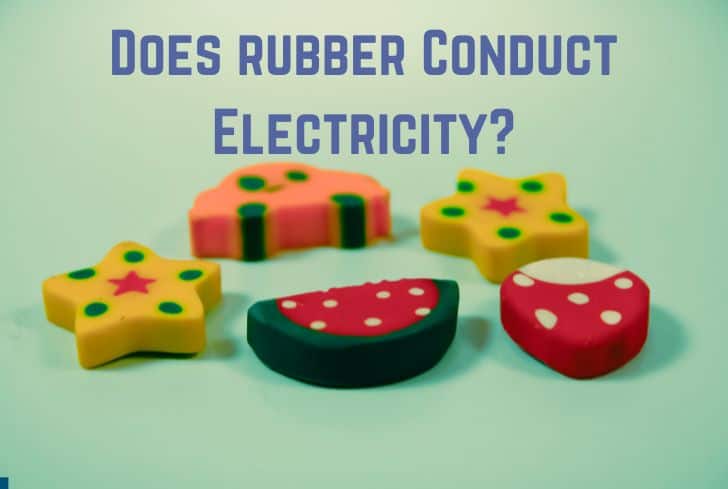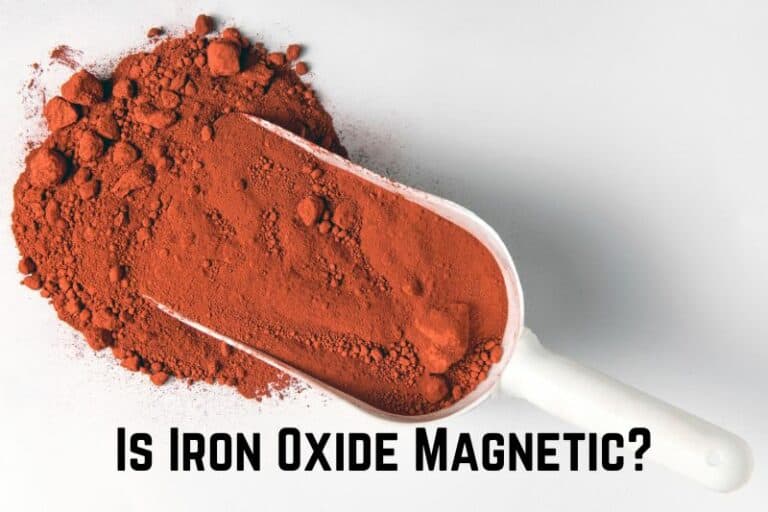Does Rubber Conduct Electricity? (Is Rubber an Insulator?)

Rubber comes from latex and is used in many manufacturing industries. It comes in a variety of forms, and you’ve pondered what its remarkable properties are. Most individuals are aware of rubber’s poor electrical conductivity. So does rubber conduct electricity?
That is what this article will tell you. We also explain whether silicon rubber, nitrile, and wet rubber conduct electricity. You might still be curious whether rubber conducts heat or if rubber gloves also conduct electricity.
Read: Does Plastic Conduct Electricity?
Is Rubber a Conductor of Electricity?
Rubber does not conduct electricity in its natural form. Polymer-based molecules make up rubber in its pure state. Long chains of atoms bound together by chemical bonds make up polymers. Rubber’s flexibility is due to the relatively weak nature of these chemical bonds. On the other hand, electricity prefers free-flowing electrons for electric conduction.
The atom’s nucleus is surrounded by little particles called electrons. An electric current is created as they move from one atom to another.
Natural rubber, whose scientific name is Hevea brasiliensis, is the most common type of rubber. It does not conduct electricity. Rubber is produced from the latex sap of the rubber tree, and its most popular applications include the production of gloves, adhesives, and tires.
However, natural rubber that is not a conductor can be processed to become one. Several of the rubbers that conduct electricity include:
- Antistatic rubber
- Fluorinated rubber
- Silicone rubber
- ESD(electrostatic discharge) rubber
- Carbon black-filled rubber
Is Rubber a Conductor or an Insulator?
Rubber can either be a conductor or an insulator, depending on its state. Natural rubber is a good insulator. Natural rubber’s molecules change form and become electrically conducive when heated and subjected to particular chemicals. Rubber that has been treated turns into synthetic rubber made of carbon and hydrogen, which makes it a good conductor.
Rubber treated with an electrically conductive material is referred to as conductive rubber. Because of this process, the rubber will carry electricity. For safety, it is always a good idea to presume that all rubbers are conductors. Conductive rubber can be used to create the following:
- Electric cable insulation
- Electrical shielding
- Electrostatic discharge protection(ESD)
- Sensors
Copper, silver, carbon black, or other electrically conductive elements treat synthetic and natural rubber types. The new rubber is then chemically and heat cured. The cross-link formed by the rubber’s molecules gives the new rubber its tensile strength and durability. Although conductive rubber is a little more expensive, it offers more benefits than ordinary natural rubber.
Why Does Rubber Not Conduct Electricity?
Due to its structure, rubber does not conduct electricity in its natural state. It has a long polymer chain structure that restricts the free movement of electrons. The electrons in its valence shell are tightly bound together, limiting the flow of electric current. Therefore, rubber’s molecular makeup plays a significant role in its inability to conduct electricity.
Let’s examine a few reasons why rubber does not conduct electricity:
- Rubber’s non-metallic structure is held together by covalent bonds made of polymer-based fundamental units (monomers). Since these components are intertwined in a continuous chain arrangement, electric current cannot easily travel through them.
- In its low energy valence band, rubber only has weak pi bonds (non-overlapping) and strong sigma bonds (covalent bonds). The higher energy band is empty in the rubber state ( zero free electrons).
- There isn’t much energy difference between the two bands due to the placement of the pi bonds. As a result, the valence band’s bonding electrons remain tightly in position.
- The outer shell of rubber’s atomic structure lacks free electrons. As a result, an uninterrupted flow of electric current cannot happen since there are no electrons to travel from one atom to another.
The rubber’s valence electrons prevent the flow of the ions when an electrical current is run through the rubber—not releasing any electricity to the conduction band. Until rubber is heated beyond its breakdown temperature, it remains an insulator.
Does Wet Rubber Conduct Electricity?
Wet rubber conducts electricity. Dry rubber does not have free electrons that can conduct electricity. Free electrons that can conduct electricity do not exist in dry rubber. However, rubber transforms and becomes more electrically conducive when it is wet. The rubber’s electrons are separated by the water molecules. The rubber can now conduct electricity more easily.
The likelihood of rubber transmitting electricity increases with its level of moisture. Water that is impure contains salt, dirt, and other impurities. Pure water alone does not conduct electricity. However, impurities will always arise if you pour pure water upon rubber. Some of the chemicals in the rubber will come into contact with pure water, contaminating it.
When water is contaminated, it picks up impurities including calcium Ca2, sodium Na+, and magnesium Mg2 + ions. Now that these impurities are charged, electricity can pass through the wet rubber. The presence of even a few ions is sufficient to make the wet rubber conduct electricity.

Does Rubber Gloves Conduct Electricity?
It will depend on the type of rubber used to make the rubber gloves. If the primary material in your gloves is natural rubber, they won’t conduct electricity. However, if the gloves have holes or have been damaged, the electric current will leak. Your gloves will transmit electricity if they are composed of conductive rubber, like neoprene rubber.
However, you can use rubber gloves made expressly for handling electrical equipment. When working with electricity, avoid using your regular rubber gloves. How can you ensure that your gloves are made for electrical use? Use the following list as a guide:
- Confirm the highest voltage the rubber gloves can withstand. You can expect to see a number like this: 15,000V AC/25,500V. Then, you can determine if the pair is a good fit for you by looking at your existing electricity working range.
- According to NFPA (National Fire Protection Association) guidelines, electrical insulating rubber gloves might have a designated class. The voltage rating will be present in the specified class.
- Rubber clove specifically designed to prevent electric shock can come with high-quality leather protectors. The additional element guarantees that the insulation rubber layer won’t tear.
Read: Does Snow Absorb Sound?
Does Nitrile Rubber Conduct Electricity?
Nitrile rubber does not conduct electricity. It has a high electrical resistance. Nitrile rubber, also known as NBR or Nitrile Butadiene rubber, is a synthetic rubber made from acrylonitrile (ACN) and butadiene. Because there are no free electrons in the rubber, it cannot conduct electricity. Its electrons are closely linked and difficult to separate.
Nitrile rubber is used to make oil-resistant products such as fuel hoses and gaskets, in addition to its reputation as an insulator. Rubber is used in the automotive, aerospace, and power industries. But its most common use is in the power and energy industries as a coating for electrical wires.
Does Silicone Rubber Conduct Electricity?
Polymeric or silicone rubber insulators are other names for silicone insulators. Silicone rubber is utilized for insulation materials at high temperatures due to its outstanding insulating qualities. The range of resistance varies from a few Ω·cm to 103Ω·cm, depending on the type of silicon rubber used.
Pure silicon can be added to some chemicals to make them electrically conductive. The additives make it possible for electric current to pass through silicone rubber. Silicone is made up of oxygen, carbon, and silicon.
The most common additive for non-medical applications is carbon black. They are made up of raw silicone material combined with a fine carbon powder. For medical devices, however, silver-coated glass spheres are used in place of carbon black. Silver-coated glass spheres is delicate hence processing must be done carefully.
Does Rubber Conduct Heat?
Rubber is not a good conductor of heat. Its structure lacks free electrons, whose mobility would aid in heat conduction. Rubber electrons are strongly bonded, and their separation requires a lot of energy. The closely bonded electrons are not available for sharing with nearby atoms. Since electrons eventually slow down and cease to move, neither the generation nor the heat conductivity is possible.
Making kitchen items like pot handles frequently involves the usage of rubber. The rubber handle prevents heat from rising and burning your hand. Natural rubber shouldn’t be used at temperatures above 185°F, though. Under high heat, the rubber will progressively disintegrate. Look for rubber products that are temperature resistant to high temperatures.
Certain synthetic rubbers have been chemically engineered to even withstand heat of 572°F.
Some of the most common high heat resistant rubbers are:
- Chlorosulphonated polyethene rubber(CSM)
- Hydrogenated acrylonitrile-butadiene rubber (HNBR)
- Silicone
- Ethylene-propylene-diene monomer (EPDM)
- FKM
Frequently Asked Question
Does Rubber Absorb Lightning?
Although rubber is a good electrical insulator, it probably won’t protect you from lightning. The car tires or your shoes are too thin to provide any lightning protection. A lightning strike is so strong that it can melt your tires or even penetrate through your shoes.
In comparison to your home’s 120 Volts and 15 Amps, a typical lightning flash has 300 million Volts and around 30,000 Amps. If lightning strikes, rubber won’t offer much protection.
How Electricity Can Rubber Withstand?
Hard rubber has a resistivity level of 1×1013 at ρ (Ω•m) at 20 °C.
Resistivity according to the table-of-electrical-resistivity-conductivity-608499. Electrical resistivity is the measure of how strongly a material can oppose the flow of electric current.
Conclusion
Both electricity and heat cannot be conducted through natural rubber. Additionally, nitrile rubber doesn’t conduct electricity. Silicone is one type of specifically designed rubber that can transmit electricity. Due to water presence, wet rubber can also conduct electricity. When handling electrical equipment, avoid using your regular rubber gloves because conductive rubber can transmit electricity.






